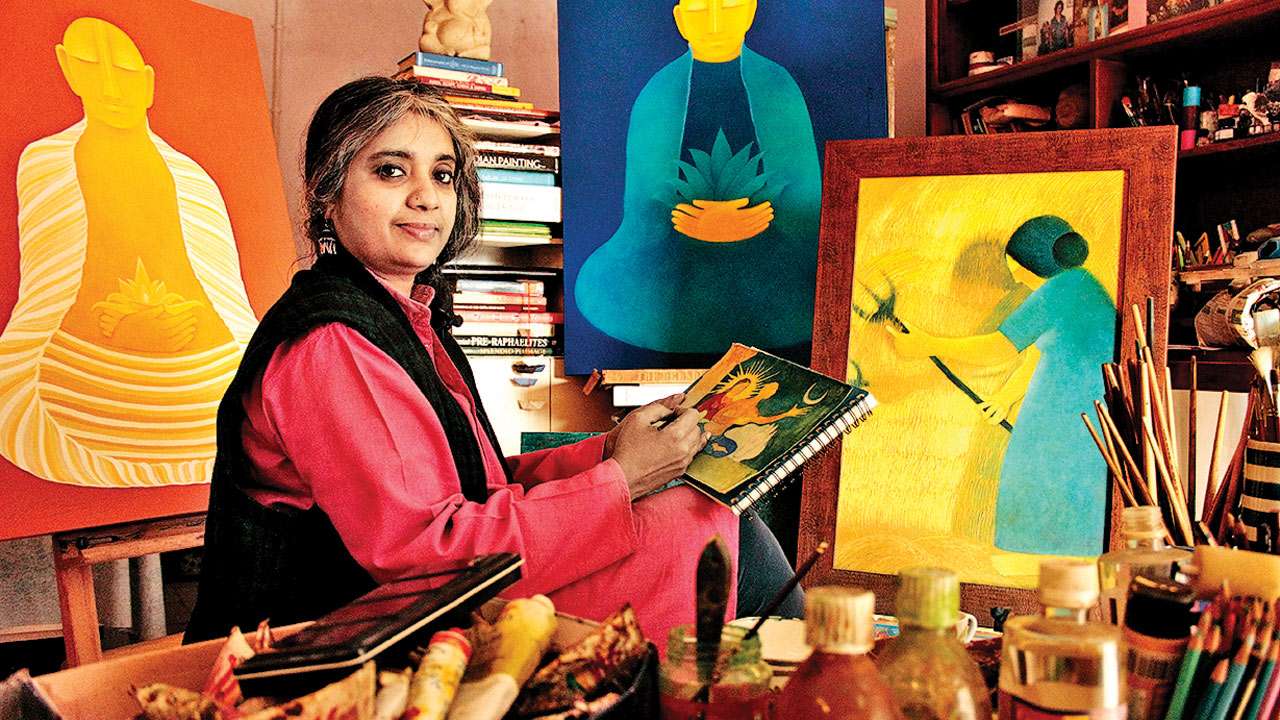
Seven sisters’ is a term with many connotations. In Greek mythology, Merope, Taygete, Maia, Electra, Alcyone, Celaeno and Asterope are daughters of Atlas – protector of the skies and Pleione, protectress of sailors. ‘Seven Sisters’ are a group of mountains in Australia, Norway and Ireland; chalk cliffs in Sussex; skyscrapers in Russia; and waterfalls in Norway. In India, ‘seven sisters’ stands for the North-East states.
But a lesser-known reference are the seven sister-goddesses of Goa – Kelbai, Mahamaya, Lairai, Mirabai (or Milagres Sabin), Morjai, Sheetalai and Adadeepa; each with their own shrine and devotees, at a distance away from each other. Bringing all the sisters together in a room at the PWD Complex, Panjim, was the Delhi-based Goan artist Sonia Rodrigues Sabharwal’s life-size paintings of them. The display was a part of the Serendipity Arts Festival 2018 at Panjim, Goa. “The worship of these sisters has produced a rich, cultural tradition in Goa. People especially adore Kelbai, Morjai, Lairai, Milagres and Mahamaya. This exhibition was my way to unite all the the sisters,” says Sabharwal.
To comprehend why Lairai holds a pot, or baby Jesus in Milagres’ arms holds a coconut shell with oil, or why Mahamaya wears a sari woven from orange firecracker flowers or abolis (state flower of Goa), a dive into the story of this divine family is must.

[(From left) Four of Sabharwal’s sister-goddesses – Morjai, Kelbai, Milagris Saibin and Lairai]
“The legend goes, the sisters, with younger brother Khetoba, travelled on an elephant from the ghats (now Western ghats) to Borda in Bicholim taluka (erstwhile Bhatagram) – a place older than the Himalayas...” begins Sanjeev Sardesai, a Goa-based botanist and heritage promoter. As Goddess Shantadurga was already the residing deity at Bicholim, she sent them to the nearby Mayem village, where they set up home.
One day Khetoba was told to arrange the fire for cooking food. When he did not return, Lairai, worried, went looking for him, and found him playing with friends. Livid, she was about to kick her brother, and he, in an escape bid twisted his back. (His images even now portray this anomaly). When Kelbai learnt what transpired, she admonished Lairai, who left home and settled at Shirgao. But she vowed return every year to walk barefoot on fire as penance, something her devotees do in a zatra in May at her temple. Lairai’s favourite sister is Mirabai who was converted to Milagres Saibin after the Portuguese arrived. On the feast of Our Lady of Miracles church, Mapusa, Christians worship the indoor idol, while Hindus pour oil on the head of the idol kept outside. Around the same time, Milagres’ devotees inturn, offer Lairai her favourite flower, mogra, on the annual Dhondachi zatra festival. Lairai has no image, and is represented by a pot full of the temple pond’s water with bud of a mogra (Arabian jasmine), which is found to stay fresh the entire year. “The bud represents the sperm and the pot with water is symbolic of the womb and amniotic fluid,” explains Sardesai.
Morjai settled in Morjim and her temple astounds with native Kaavi wall paintings, as shown in her floral backdrop in Sabarwal’s painting. When Mahamaya was afraid to settle in Mayem because of the evil spirits here, Kelbai came from Mulgao to ensure her sister’s safety. To protect her every year, Kelbai’s dhoti-clad devotees wear garlands of her favourite flower – aboli – and undertake a Peth Zatra, carrying a wicker basket (peth) with masks of four idols and run the 8kms to Mayem temple. Sheetalai, who walks into the Arabian Sea, in Sabharwal’s painting, is shown against a blue background with floral buds as wave patterns.
Festivities aside, the tale of the sisters, says Sardesai, represents the diverse nature of familial ties applicable even in today’s times. “There’s a brother who does the family wrong, a sister leaves home and performs penance, two sisters fond of each other exchange gifts... everything what happens in families today.”